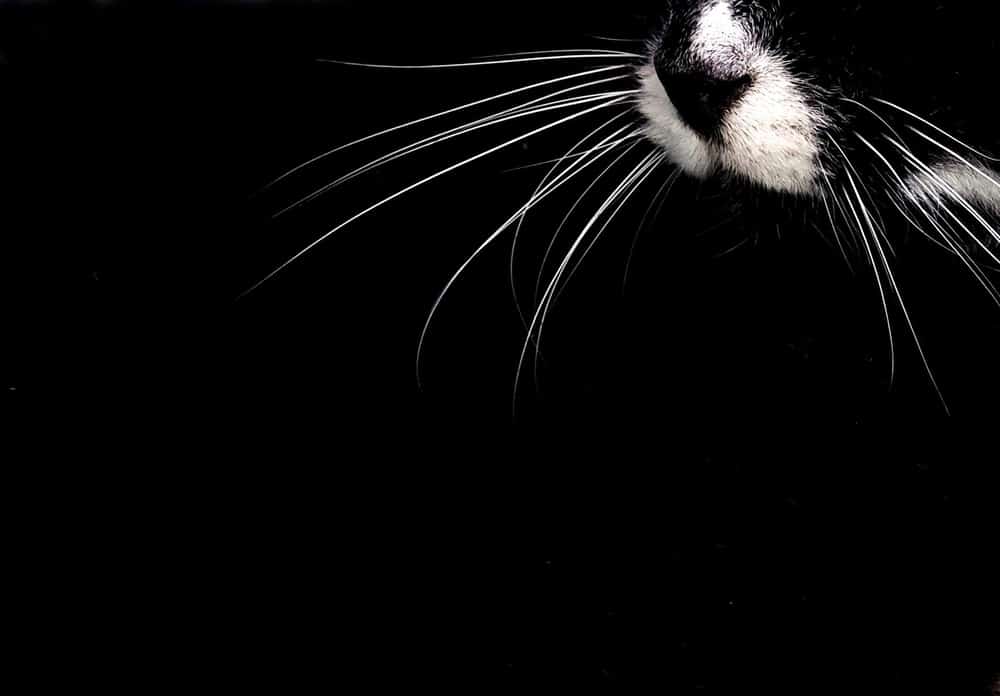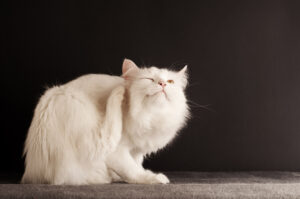I’ve often wondered: why do cats have whiskers? So, I researched the topic and put together this article to answer that question.
I get excited when I find a cat whisker in my house.
I find them on the bed, on the floor, by the bathroom sink — I sometimes find them in the strangest places. The black ones are from Samerang or Munchkin. The white ones are Periwinkle’s. And the multi-colored ones are from one of the tabbies: Phoenix or Firefly.
I used to save them, but for some reason I stopped. I can’t remember if I still have some from my Tina who passed away in 2016. I used to keep them in an envelope — maybe I’ll stumble on them some day.
So, why do cats have whiskers, anyway?
Cats’ whiskers are different from regular hair or fur.
Your cat’s whiskers are 2 to 3 times thicker than normal cat hair and are rooted more deeply. They’re found on either side of your cat’s muzzle, and these whiskers are connected to muscles that allow your cat to move them. Whiskers are also found on the jaw, above the eyes, and on the back of the forelegs. These tactile hairs are also known as vibrissae, and they have many functions.
Cats use their whiskers to help them navigate.
There’s a sensory organ at the end of the whiskers called a proprioceptor. This organ sends tactile signals to the brain and nervous system. The proprioceptor makes your cat’s whiskers sensitive to small changes in his environment.
“Seeing” in the dark
Whiskers help your cat navigate even in the dark. Cat’s use their whiskers to sense where objects are around them. Also, the proprioceptor is related to the position of the body and limbs. This helps your cat make decisions about how to move in space.

Climbing, jumping, and hunting
The whiskers on the back of the front legs also help with climbing and hunting. Since cats are farsighted, these whiskers can help your cat determine where her prey is.
Whiskers can also serve as a way for cats to measure distance which helps them leap quickly and gracefully onto narrow ledges.
Can I fit in here?
Why do cats have whiskers on their faces? The whiskers on your cats muzzle generally correspond to your cat’s body width. So, they can help her figure out if she can fit through a small space or not.
Cats express moods with their whiskers
Since cats can move their whiskers, how the whiskers are positioned will often show your cat’s mood.
A scared cat will pull her whiskers flat against her face. This position might also indicate your cat is angry.
When your cat is hunting, he will point his whiskers out in front of him in an aggressive manner. This position also indicates that something has sparked your cat’s curiosity, and he is reading the environment.
A calm, relaxed cat will have her whiskers sticking out sideways.
Fun facts about cats’ whiskers
The word “whisker” dates back to around 1600 and comes from the Middle English word “wisker” which refers to anything that whisks or sweeps.
Cats usually have about 12 whiskers on each side of their face. There are four rows on each side and the top two rows can move independently from the bottom two rows.
Whiskers do shed. Hence my delight in finding them around my house. Not to worry, they will grow back.
The world record holder for longest whiskers is a Maine coon cat that lives in Finland named Fullmoon’s Miss American Pie. In 2005, Guinness World Records recorded her whiskers at 7.5 inches long.
Never cut your cat’s whiskers. This would be akin to muting their vision and sense of touch.
Whiskers are truly a phenomenal organ, and without them, cat’s would not be able to perform most of the acrobatic feats they are know for.
If you enjoyed this article about why do cats have whiskers, please join my mailing list. I will let you know when I post a new article. Thanks!
Subscribe to Our Email List:
Here are some other cat-related articles you might be interested in.




